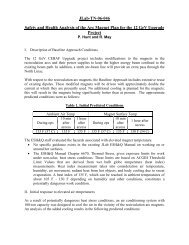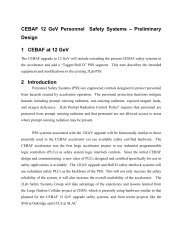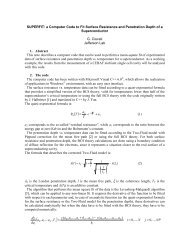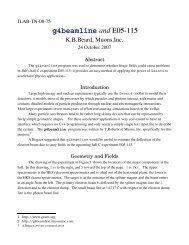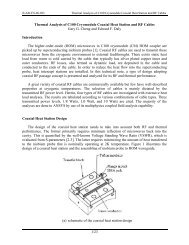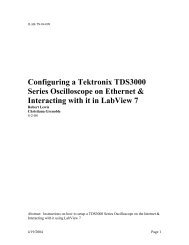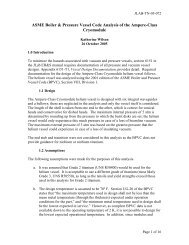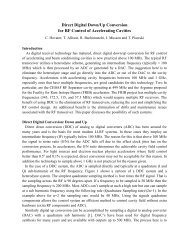Workshop on Polarized Electron Sources and Polarimeters
Workshop on Polarized Electron Sources and Polarimeters
Workshop on Polarized Electron Sources and Polarimeters
Create successful ePaper yourself
Turn your PDF publications into a flip-book with our unique Google optimized e-Paper software.
TABLE 1. Major parameters of the ILC <strong>and</strong> CLIC high-current high-polarizati<strong>on</strong> electr<strong>on</strong> sources.<br />
Parameters ILC CLIC<br />
Electr<strong>on</strong>s Per Microbunch 3x10 10<br />
6x10 9<br />
Number Of Microbunch 2625 312<br />
Width Of Microbunch 1 ns 100 ps<br />
Time Between Microbunches 360 ns 500.2 ps<br />
Width Of Macropulse 1 ms 156 ns<br />
Macropulse Repetiti<strong>on</strong> Rate 5 Hz 50 Hz<br />
Charge Per Macropulse 12600 nC 300 nC<br />
Average Current From Dc-Gun 63 A 15 A<br />
Peak Current Of Microbunch 4.8 A 9.6 A<br />
Current Intensity (1cm Radius) 1.5 A/cm 2<br />
3.0 A/cm 2<br />
Polarizati<strong>on</strong> >80% >80%<br />
COMPLETE EXPERIMENTAL CHARACTERIZATIONS OF<br />
A STRAINED-WELL InAlGaAs/AlGaAs<br />
Strained-well InAlGaAs/AlGaAs structures designed <strong>and</strong> manufactured by St.<br />
Petersburg in Russia have the following advantages [1]: 1) larger valence b<strong>and</strong><br />
splitting due to the combinati<strong>on</strong> of deformati<strong>on</strong> <strong>and</strong> quantum c<strong>on</strong>finement effects in<br />
the quantum well; 2) a sharp b<strong>and</strong>-bending-regi<strong>on</strong>; <strong>and</strong> 3) a reas<strong>on</strong>ably thick working<br />
layer without strain relaxati<strong>on</strong>. The measurements in Russia show that the structures<br />
have excellent performance – 1% QE <strong>and</strong> 90% polarizati<strong>on</strong>. To cross-check the<br />
Russian data <strong>and</strong> also provide all key performance of the cathode including charge<br />
limitati<strong>on</strong>, polarizati<strong>on</strong>, QE <strong>and</strong> QE lifetime, the InAlGaAs/AlGaAs structures have<br />
been characterized at the SLAC cathode <strong>and</strong> gun test facilities.<br />
Polarizati<strong>on</strong> <strong>and</strong> quantum efficiency were firstly measured at the SLAC Cathode<br />
Test System (CTS) [2]. The CTS is an ultra-high vacuum system equipped with a<br />
load-lock chamber through which samples can be introduced without venting the<br />
system vacuum. Polarizati<strong>on</strong> measurements are made using an electr<strong>on</strong> transport<br />
column, an electrostatic spin-rotator <strong>and</strong> a 20 kV Mott polarimeter. Prior to the<br />
cathode installati<strong>on</strong>, the sample is processed via st<strong>and</strong>ard chemical <strong>and</strong> heat cleaning<br />
methods. The CTS measurements for the InAlGaAs/AlGaAs sample dem<strong>on</strong>strate<br />
0.3% QE <strong>and</strong> 87% polarizati<strong>on</strong>. The sample used at the SLAC is not a fresh <strong>on</strong>e <strong>and</strong><br />
may have some degradati<strong>on</strong> of near-surface regi<strong>on</strong> <strong>and</strong> As-cap. The degradati<strong>on</strong> could<br />
not be removed by the st<strong>and</strong>ard chemical <strong>and</strong> heating cleaning techniques. However,<br />
the QE of the InAlGaAs/AlGaAs cathode was recovered to 1% with atomic hydrogen<br />
cleaning [3].<br />
The SLAC Gun Test Laboratory (GTL) [4] is capable of characterizing all<br />
parameters including the surface charge limit, QE <strong>and</strong> QE lifetime, <strong>and</strong> polarizati<strong>on</strong>.<br />
The GTL beamline c<strong>on</strong>sists of an ultra-high vacuum, high-voltage electrostatic dcgun,<br />
a load-lock chamber for cathode transfer <strong>and</strong> activati<strong>on</strong>, <strong>and</strong> a beamline with<br />
magnetic comp<strong>on</strong>ents for electr<strong>on</strong> beam transport. With the cathode biased at 120 kV,<br />
the gun is capable of producing a space-charge-limited current of 15 A from the 20<br />
mm diameter cathode. An electrically isolated, optically coupled nanoammeter is used<br />
to measure the average photoemissi<strong>on</strong> current. A fast Faraday Cup (FARC) is<br />
employed to measure the temporal profile of the electr<strong>on</strong> beam from which the surface



